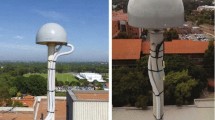Abstract
The Global Positioning System (GPS) provides satellite-based navigation signals, which are employed in many fields, including agriculture, transportation, aviation, and military/personal navigation. In an effort to minimize interference among GPS satellites and to enable GPS receivers to discern satellite identity, each satellite is assigned a specific pseudorandom noise (PRN) sequence that is used to modulate the phase of the corresponding signal. The codes that modulate the current GPS landscape are constructed in such a way that cross-correlation among codes is kept to a bounded minimum, which should significantly limit harmful signal interference. In this study, the efficacy of the current PRN-based modulation system is called into question as GPS signal amplitude and carrier phase data over the past decade show frequent interference between satellite signals.






Similar content being viewed by others
References
Balaei AT, Akos DM (2011) Cross correlation impacts and observations in GNSS receivers. Navig J Inst Navig 58(4):323–333
Bhandari V, O’Keefe K (2016) What is Doppler collision and is it a problem in GNSS? Inside GNSS 11(1):26–36
Bhandari V, O’Keefe K (2017) Characterization of Doppler collision and its impact on carrier phase ambiguity resolution using geostationary satellites. GPS Solut 21(4):1707–1720
Budden KG (1985) The propagation of radio waves: the theory of radio waves of low power in the ionosphere and magnetosphere. Cambridge University Press, Cambridge
Crane RK (1977) Ionospheric scintillation. Proc IEEE 65(2):180–199
Daubechies I (1990) The wavelet transform, time-frequency localization and signal analysis. IEEE Trans Inf Theory 36(5):961–1005
Doherty PH, Delay SH, Valladares CE, Klobuchar JA (2003) Ionospheric scintillation effects on GPS in the equatorial and auroral regions. Navig J Inst Navig 50(4):235–245
Fremouw EJ, Leadabrand RL, Livingston RC, Cousins MD, Rino CL, Fair BC, Long RA (1978) Early results from the DNA wideband satellite experiment—complex-signal scintillation. Radio Sci 13(1):167–187
Gold R (1967) Optimal binary sequences for spread spectrum multiplexing. IEEE Trans Inf Theory 13(4):619–621
Jayachandran PT et al (2009) Canadian high arctic ionospheric network (CHAIN). Radio Sci 44(1):1–10. https://doi.org/10.1029/2008RS004046
Jayachandran PT, Hamza AM, Hosokawa K, Mezaoui H, Shiokawa K (2017) GPS amplitude and phase scintillation associated with polar cap auroral forms. J Atmos Sol Terr Phys 164:185–191
Langley RB (1996) Propagation of the GPS signals. In: Teunissen PJG, Kleusberg A (eds) GPS for geodesy, vol 60. Lecture notes in earth science. Springer, Berlin, pp 103–140
Larson KM, Small EE, Gutmann E, Bilich A, Axelrad P, Braun J (2008) Using GPS multipath to measure soil moisture fluctuations: initial results. GPS Solut 12(3):173–177
Larson KM, Gutmann ED, Zavorotny VU, Braun JJ, Williams MW, Nievinski FG (2009) Can we measure snow depth with GPS receivers? Geophys Res Lett 36(17):1–5
McCaffrey AM, Jayachandran PT (2017) Observation of subsecond variations in auroral region total electron content using 100 Hz sampling of GPS observables. J Geophys Res Space Phys 122(6):6892–6900
Pan L, Yin P (2014) Analysis of polar ionospheric scintillation characteristics based on GPS data. In: China satellite navigation conference 2014 proceedings, vol 1. Springer, pp 11–18
Qaisar SU, Dempster AG (2007) An analysis of L1-C/A cross correlation & acquisition effort in weak signal environments. In: IGNSS symposium, Sydney, Australia, December 4–6, paper 107
Ragheb AE, Clarke PJ, Edwards SJ (2007) GPS sidereal filtering: coordinate- and carrier-phase-level strategies. J Geod 81(5):325–335
SBAS-IONO Working Group (2012) Ionospheric scintillations: how irregularities in electron density perturb satellite navigation systems. GPS World 23(4):44–50
Simsky A, Boon F (2003) Carrier phase and Doppler-based algorithms for real-time standalone positioning. In: Proceedings of GNSS, the European navigation conference, Graz, Austria, April 22–25, pp 1–25
Soubielle J, Fijalkow I, Duvaut P, Bibaut A (2002) GPS positioning in a multipath environment. IEEE Trans Signal Process 50(1):141–150
Spilker JJ Jr (1996) GPS signal structure and theoretical performance. In: Parkinson BW, Spiker JJ Jr et al (eds) Global positioning system: theory and applications, vol 1. American Institute of Aeronautics and Astronautics, Washington, DC, pp 57–80
Tamazin M, Noureldin A, Korenberg MJ, Kamel AM (2016) A new high-resolution GPS multipath mitigation technique using fast orthogonal search. J Navig 69(4):794–814
Van Dierendonck AJ, Arbesser-Rastburg B (2004) Measuring ionospheric scintillation in the equatorial region over Africa, including measurements from SBAS geostationary satellite signals. In: Proc. ION GNSS 2004, Institute of Navigation, Long Beach, California, USA, September 21–24, pp 316–324
Wernik AW, Secan JA, Fremouw EJ (2003) Ionospheric irregularities and scintillation. Adv Space Res 31(4):971–981
Zhu Z, Van Graas F (2014) Implications of C/A code cross correlation on GPS and GBAS. In: 2014 IEEE/ION position, location and navigation symposium, Monterey, CA, May 5–8, pp 282–293
Zhu Z, Van Graas F, Pelgrum W (2015) C/A code cross-correlation at a high Doppler offset. IEEE Trans Aerosp Electron Syst 51(3):1826–1838
Acknowledgements
Infrastructure funding for CHAIN was provided by the Canadian Foundation for Innovation and the New Brunswick Innovation Foundation. CHAIN operation is conducted in collaboration with the Canadian Space Agency. This research was undertaken with the financial support of the Canadian Space Agency FAST program and the Natural Sciences and Engineering Research Council of Canada.
Author information
Authors and Affiliations
Corresponding author
Ethics declarations
Conflict of interest
The authors declare that they have no conflict of interest.
Additional information
Publisher's Note
Springer Nature remains neutral with regard to jurisdictional claims in published maps and institutional affiliations.
Rights and permissions
About this article
Cite this article
Flynn, C.D., McCaffrey, A.M., Jayachandran, P.T. et al. Discovery of new code interference phenomenon in GPS observables. GPS Solut 23, 65 (2019). https://doi.org/10.1007/s10291-019-0858-7
Received:
Accepted:
Published:
DOI: https://doi.org/10.1007/s10291-019-0858-7




